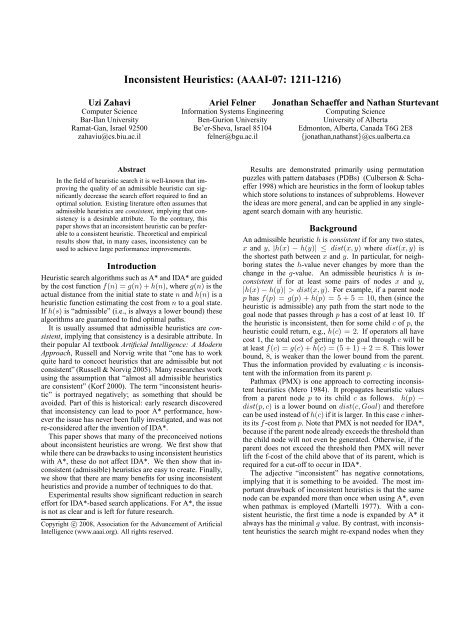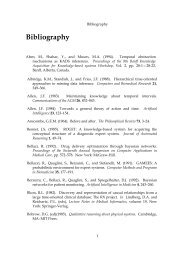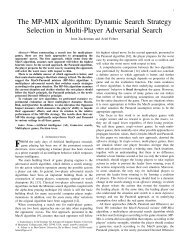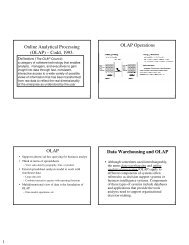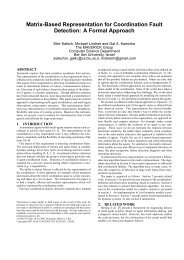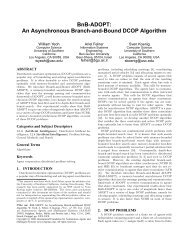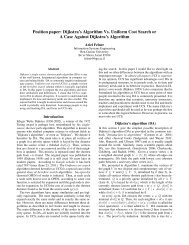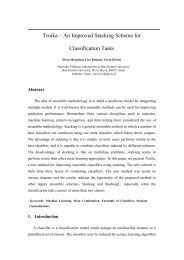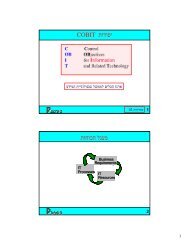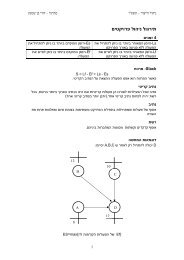Inconsistent Heuristics: (AAAI-07: 1211-1216)
Inconsistent Heuristics: (AAAI-07: 1211-1216)
Inconsistent Heuristics: (AAAI-07: 1211-1216)
You also want an ePaper? Increase the reach of your titles
YUMPU automatically turns print PDFs into web optimized ePapers that Google loves.
<strong>Inconsistent</strong> <strong>Heuristics</strong>: (<strong>AAAI</strong>-<strong>07</strong>: <strong>1211</strong>-<strong>1216</strong>)<br />
Uzi Zahavi<br />
Computer Science<br />
Bar-Ilan University<br />
Ramat-Gan, Israel 92500<br />
zahaviu@cs.biu.ac.il<br />
Ariel Felner Jonathan Schaeffer and Nathan Sturtevant<br />
Information Systems Engineering<br />
Computing Science<br />
Ben-Gurion University<br />
University of Alberta<br />
Be’er-Sheva, Israel 85104 Edmonton, Alberta, Canada T6G 2E8<br />
felner@bgu.ac.il<br />
{jonathan,nathanst}@cs.ualberta.ca<br />
Abstract<br />
In the field of heuristic search it is well-known that improving<br />
the quality of an admissible heuristic can significantly<br />
decrease the search effort required to find an<br />
optimal solution. Existing literature often assumes that<br />
admissible heuristics are consistent, implying that consistency<br />
is a desirable attribute. To the contrary, this<br />
paper shows that an inconsistent heuristic can be preferable<br />
to a consistent heuristic. Theoretical and empirical<br />
results show that, in many cases, inconsistency can be<br />
used to achieve large performance improvements.<br />
Introduction<br />
Heuristic search algorithms such as A* and IDA* are guided<br />
by the cost function f(n) = g(n) + h(n), where g(n) is the<br />
actual distance from the initial state to state n and h(n) is a<br />
heuristic function estimating the cost from n to a goal state.<br />
If h(s) is “admissible” (i.e., is always a lower bound) these<br />
algorithms are guaranteed to find optimal paths.<br />
It is usually assumed that admissible heuristics are consistent,<br />
implying that consistency is a desirable attribute. In<br />
their popular AI textbook Artificial Intelligence: A Modern<br />
Approach, Russell and Norvig write that “one has to work<br />
quite hard to concoct heuristics that are admissible but not<br />
consistent” (Russell & Norvig 2005). Many researches work<br />
using the assumption that “almost all admissible heuristics<br />
are consistent” (Korf 2000). The term “inconsistent heuristic”<br />
is portrayed negatively; as something that should be<br />
avoided. Part of this is historical: early research discovered<br />
that inconsistency can lead to poor A* performance, however<br />
the issue has never been fully investigated, and was not<br />
re-considered after the invention of IDA*.<br />
This paper shows that many of the preconceived notions<br />
about inconsistent heuristics are wrong. We first show that<br />
while there can be drawbacks to using inconsistent heuristics<br />
with A*, these do not affect IDA*. We then show that inconsistent<br />
(admissible) heuristics are easy to create. Finally,<br />
we show that there are many benefits for using inconsistent<br />
heuristics and provide a number of techniques to do that.<br />
Experimental results show significant reduction in search<br />
effort for IDA*-based search applications. For A*, the issue<br />
is not as clear and is left for future research.<br />
Copyright c○ 2008, Association for the Advancement of Artificial<br />
Intelligence (www.aaai.org). All rights reserved.<br />
Results are demonstrated primarily using permutation<br />
puzzles with pattern databases (PDBs) (Culberson & Schaeffer<br />
1998) which are heuristics in the form of lookup tables<br />
which store solutions to instances of subproblems. However<br />
the ideas are more general, and can be applied in any singleagent<br />
search domain with any heuristic.<br />
Background<br />
An admissible heuristic h is consistent if for any two states,<br />
x and y, |h(x) − h(y)| ≤ dist(x, y) where dist(x, y) is<br />
the shortest path between x and y. In particular, for neighboring<br />
states the h-value never changes by more than the<br />
change in the g-value. An admissible heuristics h is inconsistent<br />
if for at least some pairs of nodes x and y,<br />
|h(x) − h(y)| > dist(x, y). For example, if a parent node<br />
p has f(p) = g(p) + h(p) = 5 + 5 = 10, then (since the<br />
heuristic is admissible) any path from the start node to the<br />
goal node that passes through p has a cost of at least 10. If<br />
the heuristic is inconsistent, then for some child c of p, the<br />
heuristic could return, e.g., h(c) = 2. If operators all have<br />
cost 1, the total cost of getting to the goal through c will be<br />
at least f(c) = g(c) + h(c) = (5 + 1) + 2 = 8. This lower<br />
bound, 8, is weaker than the lower bound from the parent.<br />
Thus the information provided by evaluating c is inconsistent<br />
with the information from its parent p.<br />
Pathmax (PMX) is one approach to correcting inconsistent<br />
heuristics (Mero 1984). It propagates heuristic values<br />
from a parent node p to its child c as follows. h(p) −<br />
dist(p, c) is a lower bound on dist(c, Goal) and therefore<br />
can be used instead of h(c) if it is larger. In this case c inherits<br />
its f-cost from p. Note that PMX is not needed for IDA*,<br />
because if the parent node already exceeds the threshold than<br />
the child node will not even be generated. Otherwise, if the<br />
parent does not exceed the threshold then PMX will never<br />
lift the f-cost of the child above that of its parent, which is<br />
required for a cut-off to occur in IDA*.<br />
The adjective “inconsistent” has negative connotations,<br />
implying that it is something to be avoided. The most important<br />
drawback of inconsistent heuristics is that the same<br />
node can be expanded more than once when using A*, even<br />
when pathmax is employed (Martelli 1977). With a consistent<br />
heuristic, the first time a node is expanded by A* it<br />
always has the minimal g value. By contrast, with inconsistent<br />
heuristics the search might re-expand nodes when they
are reached via a shorter path, especially if many small cycles<br />
exist. This operation is sometimes referred to as the<br />
reopening of nodes, since nodes from the closed list are reopened<br />
and moved back to the open list. An example is<br />
shown in Figure 1. Assume that all edges have a weight<br />
of 1 except edge (d, G) which has weight 5. Nodes are labeled<br />
with their h-values. With A* (even with PMX) nodes<br />
a (f(a) = 1) and b (f(b) = 6) are generated first. Next,<br />
node a is expanded, then c, leading to the expansion of node<br />
d (f(d) = 3). There is no path to the goal of cost less than<br />
or equal to 6 so A* returns to node b. Expanding b results in<br />
reopening node d (with a new cost of f(d) = 6). Now the<br />
g-value of d is the minimal value. The optimal path to the<br />
goal has been found, but d was expanded twice.<br />
I<br />
a<br />
b<br />
0<br />
5<br />
0<br />
c<br />
0<br />
5<br />
d<br />
Figure 1: Reopening of nodes with A*<br />
With IDA*, d will be expanded twice, once for each of<br />
the paths, regardless of whether the heuristic is consistent<br />
or inconsistent. Thus the problem of re-expanding nodes<br />
already exists in IDA*, and using inconsistent heuristics will<br />
not make this behavior worse. This paper concentrates on<br />
IDA*, returning to the issues surrounding A* at the end.<br />
In most previous work on admissible heuristics, research<br />
concentrated on improving the quality of the heuristic assessment.<br />
A heuristic h 1 is considered to be more informed<br />
(better quality) than h 2 if it usually returns higher values for<br />
arbitrary states. For a state s, a more informed heuristic generally<br />
improves the f(s) value and increases the chance of<br />
a cutoff in the search. In the 15-puzzle, for example, there<br />
have been massive performance gains seen through the development<br />
of more informed heuristics (20 years of research<br />
have led a reduction of four orders of magnitude.)<br />
A de facto standard usually used by researchers (e.g.,<br />
(Korf 1997; Korf & Felner 2002; Felner et al. 2004)) for<br />
comparing the “informedness” of heuristics is to compare<br />
the average values of a given heuristic over the entire domain<br />
space or, if not practical, over a large sample of states<br />
of the domain. This paper demonstrates that, while the average<br />
heuristic value is important, there are other considerations<br />
that can influence the effectiveness of the heuristic.<br />
Achieving <strong>Inconsistent</strong> <strong>Heuristics</strong><br />
As illustrated earlier, there is a perception that inconsistent<br />
admissible heuristics are hard to create. However, inconsistent<br />
heuristics have been used effectively in a number of applications,<br />
including puzzles (Zahavi et al. 2006), pathfinding<br />
(Likhachev & Koenig 2005), learning real-time A* and<br />
Moving Target Search (Shimbo & Isida 2000). Furthermore,<br />
it is very easy to generate inconsistent heuristics with PDBs.<br />
Three examples follow. The first is the most general. It is<br />
new and is explored further in this paper.<br />
1: Random selection of heuristics: A well-known<br />
method for overcoming pitfalls of a given heuristic is to<br />
G<br />
consult a number of heuristics and use their maximum. Of<br />
course, there is a tradeoff for doing this—each heuristic calculation<br />
increases the time it takes to compute h(s). Additional<br />
heuristic consultations provide diminishing returns, in<br />
terms of the reduction in the number of nodes generated, so<br />
it is not always best to use them all.<br />
Given a number of heuristics one could alternatively select<br />
which heuristic to use randomly. One benefit is that only<br />
a single heuristic will consulted at each node. Random selection<br />
between heuristics will produce inconsistent values<br />
if there is no (low) correlation between the heuristics.<br />
Multiple heuristics often arise from domain-specific geometrical<br />
symmetries, meaning that there are no additional<br />
storage costs associated with these extra heuristics.<br />
2: Dual heuristics: In permutation spaces, for each state<br />
s there exists a dual state s d which shares many important<br />
attributes with s, such as the distance to the goal (Felner<br />
et al. 2005; Zahavi et al. 2006). Therefore, any admissible<br />
heuristic applied to s d is also admissible for s. In the<br />
permutation space puzzles used in this paper, the role of locations<br />
and objects (values) can be reversed; the “regular”<br />
state uses a set of objects indexed by their current location,<br />
while the “dual” state has a set of location indexed by the<br />
objects they contain. Both mappings can be looked up in<br />
the same PDB and return an admissible value. Performing<br />
only regular PDB lookups for the states generated during<br />
the search produces consistent values. However, the values<br />
produced by performing the dual lookup can be inconsistent<br />
because the identity of the objects being queried can change<br />
dramatically between two consecutive lookups.<br />
3: Compressed PDBs: Larger PDBs tend to be more accurate<br />
than smaller PDBs and thus reduce the number of<br />
generated nodes. Lossy PDB compression, by storing the<br />
minimum of a group of PDB entries in one entry, proved to<br />
preserve most of the information of the larger (more accurate<br />
PDB) but with less space (Felner et al. 2004). Heuristic<br />
values obtained by compressed PDBs might be inconsistent<br />
even if the original PDB heuristic is consistent, because the<br />
PDB values for two neighboring nodes can be compressed<br />
into two different entries in the compressed PDB.<br />
In summary, there are two easy ways to generate inconsistent<br />
heuristics: 1) the use of multiple different heuristics<br />
(e.g., symmetries, dual states), and 2) using a heuristic that<br />
has some values missing or degraded (e.g.,compression).<br />
This list is not exhaustive and the above examples are by<br />
no means the only ways of creating inconsistent heuristics.<br />
Benefits of Inconsistency<br />
Consider a consistent heuristic that is being applied to state<br />
s in a region of the search space where the heuristic is a<br />
poor estimator of the true distance to the goal. Since the<br />
heuristic is consistent, each of the children of s have a value<br />
that differs from that of s by at most c, where c is the cost<br />
of the operator used to reach them. In other words, the value<br />
of a node and its children are correlated. A search algorithm<br />
will incur significant costs before it is able to escape this<br />
region of poor heuristic values.<br />
Consider using an inconsistent heuristic. <strong>Heuristics</strong> that<br />
arise from random or dual lookups might have no correla-
2<br />
5 1 5<br />
4<br />
3<br />
Figure 2: Bidirectional pathmax<br />
tion or only little correlation between the heuristic value of<br />
s and that of the children of s. Thus when reaching a state<br />
with a poor heuristic estimation, a child of s might have a<br />
much larger heuristic value – possibly large enough to escape<br />
from this region of the search space. This can be done<br />
with bidirectional pathmax (BPMX) which we introduced<br />
in (Felner et al. 2005). BPMX further improves the original<br />
pathmax method and is illustrated in Figure 2. The left<br />
side of the figure shows the (inconsistent) heuristic values<br />
for a node and its two children. When the left child is generated,<br />
its heuristic (h = 5) can propagate up to the parent<br />
and then down again to the right child. To preserve admissibility,<br />
each propagation reduces h by the cost of traversing<br />
that path (1 in this example). This results in h = 4 for the<br />
root and h = 3 for the right child. Note that BPMX is only<br />
applicable for undirected graphs. When using IDA*, BPMX<br />
can cause many nodes to be pruned that would otherwise be<br />
expanded. For example, suppose the current IDA* threshold<br />
is 2. Without the propagation of h from the left child, both<br />
the root node (f = g + h = 0 + 2 = 2) and the right child<br />
(f = g +h = 1+1 = 2) would be expanded. Using BPMX,<br />
the left child will improve the parent’s h value to 4, resulting<br />
in a cutoff without even generating the right child.<br />
In summary, inconsistent heuristics are valuable when the<br />
values are not highly correlated between neighboring nodes.<br />
This greatly reduces the chance of entering a region of the<br />
search space where all the heuristic values are low. Because<br />
heuristic values can be propagated with PMX and BPMX, a<br />
single node with a good heuristic may be sufficient to direct<br />
the search into better parts of the search space.<br />
Static Distribution and Korf’s Formula<br />
The distribution of values from a heuristic function can be<br />
used to measure the “informedness” of the function. Typically<br />
this distribution is statically computed over the space<br />
of all possible states or, if impractical, a large random sample<br />
of states. Doing this for admissible heuristics will usually<br />
show that if a heuristic is more informed then the distribution<br />
of values will be higher, as will be the average value.<br />
(Korf, Reid, & Edelkamp 2001) suggested that the number<br />
of nodes expanded by IDA* with a consistent admissible<br />
heuristic is N(b, c, P ) = ∑ d<br />
i=0 bi P (c − i) where b is the<br />
brute-force branching factor, c is the depth of the search and<br />
P is the static distribution function of heuristics. They first<br />
showed that the expected number of all nodes n such that<br />
f(n) ≤ c is equal to N(b, c, P ). These nodes have the potential<br />
to be expanded. They then proved that all the potential<br />
nodes will eventually be expanded by IDA* as follows.<br />
Assume that n is a potential node. Since the heuristic is consistent<br />
then any ancestor of n, p, must also have f(p) ≤ c<br />
and is also a potential node. Then, by induction they showed<br />
that the entire branch from the root to n will be expanded<br />
since all the nodes of the branch are potential nodes.<br />
For inconsistent heuristics this is not necessarily true.<br />
Compare, for example, the dual (or random) PDB lookup<br />
to the regular consistent lookup of the same PDB. Since exactly<br />
the same PDB is used, all heuristics will have the same<br />
static distribution of values. Thus, according to Korf’s formula,<br />
the number of potential nodes (i.e., their f(n) ≤ c)<br />
will again be N(b, c, P ). However, Korf’s proof that given<br />
a potential node n all its ancestors must also be potential<br />
nodes is not true. Due to inconsistency there might exist<br />
an ancestor p with f(p) > c. Once IDA* visits this node<br />
the entire subtree below it is pruned and n will not even be<br />
generated. A potential node will be expanded only if all<br />
its ancestors are also potential nodes. This is guaranteed<br />
for consistent heuristics but not for inconsistent heuristics.<br />
Thus, for inconsistent heuristic N(b, c, P ) is only an upper<br />
bound on the number of generated nodes.<br />
consistent<br />
4<br />
3<br />
expanded<br />
generated<br />
not generated<br />
5<br />
3 3 3 4 6<br />
inconsistent<br />
4<br />
3 5<br />
3 6 3 4 3<br />
Figure 3: Consistent versus inconsistent heuristics<br />
An example of the difference between consistent and inconsistent<br />
heuristics is shown in Figure 3. Nodes are marked<br />
with their h-value. Observe that in both cases we have exactly<br />
the same h-value distribution in the various levels of<br />
the tree. For the consistent case, if the current IDA* threshold<br />
is 5, all 3 nodes at depth 2 with h-value of 3 have<br />
f = g + h = 2 + 3 = 5 and will be expanded. The right<br />
subtree is pruned because the f-value of the right node at<br />
level 1 is f = g + h = 1 + 5 = 6 > 5. For the inconsistent<br />
case, however, only one node at depth 2 will be expanded –<br />
the leftmost node. The second node with h-value of 6 will<br />
be generated but not expanded because its f-value is 8 and<br />
exceeds the threshold. Due to BPMX, its value will be propagated<br />
to its parent and its right sibling (a potential node<br />
with h = 3) will not even be generated. The right subtree<br />
will be pruned again and, due to PMX, the rightmost node –<br />
with h-value of 3 – will not be generated.<br />
Dynamic Distribution of Heuristic Values<br />
There is no guarantee that the static distribution of values<br />
in a heuristic will have the same distribution as the values<br />
actually considered during search. What makes a heuristic<br />
effective is not its overall static distribution but the dynamic<br />
distribution of the values generated during search.<br />
The idea of static and dynamic distributions of heuristic<br />
values is not new; it has been previously used to explain why<br />
the maximum of several weak heuristics can outperform one<br />
stronger heuristic (Holte et al. 2006). In this paper we examine<br />
the distributions generated by inconsistent heuristics<br />
and analyze their influence on the search.
# No Lookup Nodes Time<br />
One PDB lookup<br />
1 1 Regular 90,930,662 28.18<br />
2 1 Dual 19,653,386 7.38<br />
3 1 Dual + BPMX 8,315,116 3.24<br />
4 1 Random 9,652,138 3.30<br />
5 1 Random + BPMX 3,829,138 1.25<br />
Maxing over multiple PDB lookups<br />
6 2 Regular 13,380,154 7.85<br />
7 4 Regular 10,574,180 11.60<br />
8 2 Random + BPMX 1,902,730 1.14<br />
9 4 Random + BPMX 1,042,451 1.20<br />
Table 1: Rubik’s Cube results for 100 instances<br />
To illustrate the impact of inconsistent heuristics on the<br />
search we use Rubik’s Cube which has 20 movable cubes<br />
(or “cubies”); 8 are corners and 12 are edges. The 8-corners<br />
PDB (first used by (Korf 1997)) cannot be used here because<br />
it is always consistent since all 8 corners are always<br />
examined. We experimented with a large variety of other<br />
PDBs where inconsistency can be achieved. For example,<br />
we added a single edge cubie to the 8-corner PDB resulting<br />
in a large PDB with 9 cubies. For compatibility, we chose<br />
to report the results for the same 7-edge PDB that we used<br />
in (Felner et al. 2005; Zahavi et al. 2006) but similar tendencies<br />
were observed in our other experiments. There are<br />
24 lines of geometrical symmetries, which arise from different<br />
ways to rotate and reflect the cube. For our 7-edge<br />
PDB, each of these symmetries considers a different set of<br />
edges, and thus results in a different PDB lookup. The traditional<br />
(“regular”) and dual state (“dual”) PDB lookups implemented<br />
in (Felner et al. 2005) was used for comparison.<br />
Table 1 shows the average number of generated nodes and<br />
the average running time over the same set of 100 depth-<br />
14 Rubik’s cube instances taken from (Felner et al. 2005).<br />
Column No gives the number of PDB lookups used. The<br />
following PDB lookups were used for lines 1 − 5:<br />
Regular: The regular PDB lookup. This heuristic is consistent<br />
because the same set of cubies is used for the PDB<br />
lookup of both parent and child nodes.<br />
Dual: For each node, the dual state is calculated and is<br />
looked up in the PDB. This will produce inconsistent heuristic<br />
values because the dual lookup of the parent might consult<br />
different cubies than the dual lookup of the child.<br />
Random: Randomly select one of the different 24 possible<br />
symmetric PDB lookups for the given node. This is<br />
inconsistent because the set of cubies that are used for the<br />
parent are not necessarily the same as for the child.<br />
The table shows that a random lookup (with BPMX) is<br />
much faster than either one regular lookup (a factor of 24)<br />
or one dual lookup (a factor of 2). Lines 6-9 shows the<br />
results of maximizing over a number of regular and random<br />
lookups. It is interesting to note that even one random<br />
lookup (line 5) generates just one third of the nodes<br />
than with 4 regular lookups (line 7). Note that performing<br />
more PDB lookups can only decrease the number of nodes<br />
but there is a diminishing return in terms of time because<br />
each PDB lookup incurs overhead. The best time for regular<br />
# No Lookup Nodes Time<br />
One PDB lookup<br />
1 1 Regular 136,289 0.081<br />
2 1 Dual + BPMX 247,299 0.139<br />
3 1 Random + BPMX 44,829 0.029<br />
Maxing over multiple PDB lookups<br />
4 2 Regular* 36,710 0.034<br />
5 2 2 Randoms + BPMX 26,863 0.025<br />
6 3 3 Randoms + BPMX 21,425 0.026<br />
7 4 Regular* + Dual* + BPMX 18,601 0.022<br />
Table 2: Random lookups on the 15-puzzle<br />
PDB lookups (2 regular lookups, line 6) was improved by<br />
one random lookup (line 5) by factor of 5.<br />
% Nodes<br />
60<br />
50<br />
40<br />
30<br />
20<br />
10<br />
Dynamic Regular<br />
Dynamic Dual<br />
Dynamic Random<br />
Static<br />
0<br />
0 2 4 6 8 10 12<br />
Heuristic Value<br />
Figure 4: Rubik’s Cube value distributions<br />
Figure 4 shows the distribution of the heuristic values seen<br />
during the searches of Table 1. We make the following observations<br />
from these results. First, note the dramatic difference<br />
between the static distribution of values and the dynamic<br />
distribution for the regular (consistent) heuristic. As<br />
pointed out by others, the static distribution is a poor approximation<br />
of the dynamic distribution (Holte et al. 2006). Second,<br />
it is easy to recognize that the heuristic that performed<br />
the best also had a higher distribution of heuristic values.<br />
Note that all these versions used exactly the same PDB with<br />
the same overall static distribution of values. Third, the regular<br />
heuristic did not gain from the potential of the static<br />
distribution because it is consistent; when the heuristic for a<br />
state is low, the children of that state will also have low values.<br />
The inconsistent heuristics do not have this problem;<br />
a node can receive any value, meaning that the distribution<br />
of values seen is closer to the potential of the static distribution.<br />
Finally, inconsistency has the effect of improving the<br />
dynamic runtime distribution towards that of the static distribution.<br />
The greater the level of inconsistency, the closer<br />
the dynamic distribution approaches the static distribution.<br />
Table 2 shows similar results for the 15-puzzle based<br />
based on the four possible lookups of the 7-8 additive PDBS<br />
from (Korf & Felner 2002). In the table, the “*” indicates<br />
the use of the state and its reflection. Again, the benefit of<br />
random is shown. A single random lookup (line 3) clearly<br />
outperforms a single regular lookup (line 1) but it is also<br />
faster than the best results of (Korf & Felner 2002) (line 4).
Inconsistency Rate<br />
An inconsistent heuristic is most useful if there is a low correlation<br />
between heuristic values in adjacent states. To better<br />
understand the behavior of the different heuristics, two new<br />
terms are introduced:<br />
1) Inconsistency rate of an edge (IRE): The inconsistency<br />
rate of a heuristic h and an edge e = (m, n) is the<br />
difference in the heuristic value for the two nodes incident<br />
to this edge. IRE(h, e) = |h(m) − h(n)|. The IRE of the<br />
entire domain is defined as the average IRE over the entire<br />
set of edges of the state space.<br />
2) Inconsistency rate of a node (IRN): For a given node,<br />
choose the incident edge with the maximum inconsistency<br />
rate. IRN(h, n) = max m∈adj(n) |h(m) − h(n)|. The IRN<br />
of the entire domain is defined as the average IRN over the<br />
entire set of nodes of the state space.<br />
For a consistent heuristic with a uniform edge cost of 1<br />
(as in Rubik’s Cube), both the IRN and IRE for all edges<br />
and nodes are less than or equal to 1.<br />
The performance of a search can also be characterized by<br />
its branching factor. The dynamic branching factor (DBF) is<br />
defined to be the average number of children that are generated<br />
for each node that is expanded in the search. When the<br />
heuristic function is inconsistent and BPMX is employed,<br />
the dynamic branching factor can dramatically decrease.<br />
# IRE IRN DBF Nodes BPMX Cuts<br />
1 0.434 1.000 13.355 90,930,662 0<br />
2 0.490 1.237 9.389 17,098,875 717,151<br />
3 0.510 1.306 9.388 14,938,502 623,554<br />
5 0.553 1.424 7.152 5,132,396 457,253<br />
8 0.571 1.467 7.043 4,466,428 402,560<br />
12 0.597 1.527 7.036 3,781,716 337,114<br />
16 0.6<strong>07</strong> 1.552 6.867 3,822,422 356,327<br />
20 0.608 1.558 6.852 3,819,699 357,436<br />
24 0.609 1.561 6.834 3,829,139 360,067<br />
dual 0.441 1.358 7.681 8,315,117 796,849<br />
Table 3: Rubik’s Cube: random heuristic with BPMX<br />
Table 3 presents results for these new measurements on<br />
Rubik’s Cube obtained using the 7-edges PDB. There are<br />
24 possible symmetric lookups that could be used. We varied<br />
the number of possible symmetries that random could<br />
choose from to perform a single lookup. The first column<br />
gives this number. The next columns present the IRE and<br />
IRN averaged over 100 Million random states. The last three<br />
columns show results averaged over the same set instances<br />
of table 1 for searches with the particular random heuristic.<br />
We report the DBF, the number of nodes that were generated<br />
and the number of times that BPMX was used in the search.<br />
In the first row, only one symmetry was allowed and thus<br />
the same PDB lookup was performed at all times. This is the<br />
benchmark case of a single consistent regular PDB heuristic<br />
lookup. Note that the IRE is close to 0.5, implying that the<br />
difference in the heuristic for two neighboring nodes was<br />
roughly 0 half the time, and 1 the other half. The IRN was<br />
exactly 1 showing that for each node in Rubik’s Cube there<br />
exists at least one neighbor whose heuristic is different by 1.<br />
The dynamic branching factor here is equal to 13.355, which<br />
is consistent with the results in (Korf 1997).<br />
As the heuristic randomly considers progressively more<br />
symmetries, the inconsistency rates increase and the DBF<br />
decreases. This results in a significant reduction in the number<br />
of generated nodes. It is important to note two issues<br />
here. First, the range of heuristic values in Rubik’s Cube is<br />
rather small, as can be seen in Figure 4. Thus, the potential<br />
for a large inconsistency rate is rather modest. However,<br />
even in this domain, a rather small IRN of 1.5 caused a dramatic<br />
speedup in the search. Second, no extra overhead is<br />
needed by these heuristics as only a single PDB lookup is<br />
performed at each node. Thus, the reduction in nodes is fully<br />
reflected in the running times.<br />
Decreasing the Effective Branching Factor<br />
When performing BPMX cutoffs the DBF decreases. As<br />
stated previously, we can generate BPMX cutoffs when the<br />
heuristic value of a child is larger than the heuristic of the<br />
parent by more than 1, assuming an edge cost of 1. Thus,<br />
if such a child exists, we would like to generate it as fast<br />
as possible. If, in a particular domain, the operators have<br />
different inconsistency rates, we can order the application of<br />
operators to maximize the chance of a BPMX cutoff.<br />
The operators on Rubiks cube are symmetric, there is no<br />
way to order them. Thus, we demonstrate this in the pancake<br />
puzzle Imagine a waiter with a stack of n pancakes.<br />
The waiter wants to sort the pancakes ordered by size. The<br />
only available operation is to lift a top portion of the stack<br />
and reverse it. Here, a state is a permutation of the values<br />
0...(N − 1). The size of this state space is N! and there is<br />
a uniform static branching factor of N − 1. The k th successor<br />
formed by reversing the order of the first k + 1 elements<br />
of the permutation (1 ≤ k < N). An important attribute<br />
of this domain is that the number of tokens (pancakes) that<br />
change their locations is different for each of the operators.<br />
As we noted in (Zahavi et al. 2006), here, there are no possible<br />
geometrical symmetric PDB lookups and the only way<br />
to achieve inconsistency is with the dual lookup.<br />
Regular<br />
Dual<br />
Op Max IRE Max IRE<br />
2-10 1 0.370 - 0.397 0 0<br />
11 1 0.396 2 0.613<br />
12 1 0.397 4 0.958<br />
13 1 0.400 6 1.165<br />
14 1 0.401 8 1.291<br />
15 1 0.402 9 1.358<br />
16 1 0.411 10 1.376<br />
17 1 0.216 9 1.321<br />
Table 4: IRE for operators of the 17-pancake<br />
Table 4 shows different measurements on the operators of<br />
the 17 pancake puzzle. To measure the inconsistency rate of<br />
an operator, we first chose a random state, s 1 . We then performed<br />
the relevant operator on this state, arriving at state s 2 ,<br />
and measured the difference in the heuristic value between<br />
s 1 and s 2 . This was repeated for 100 million different states.
The Max column presents the maximal heuristic difference<br />
(maximal IRE) found for the specific operator. The IRE column<br />
presents the average IRE over all instances. Similar<br />
measurements are reported for the dual PDB lookup.<br />
The regular PDB lookup is consistent. Indeed, the table<br />
shows that for all the operators, the maximal IRE was 1 and<br />
the average IRE was smaller than 0.5. For the dual PDB<br />
lookups the results are more interesting. First, we note that<br />
for operators 2-10 all the IRE values were exactly 0. This is<br />
an artifact of the particular PDB used for these experiments<br />
(which are based on locations 11-17). The dual lookup of<br />
this PDB was not changed by operators 2-10. But, for larger<br />
operators (13-17), the IRE for the dual lookup is more than<br />
1. Note that operator 16 has a larger IRE than operator 17<br />
even though it only changes a smaller number of locations.<br />
# Lookup Order Nodes DBF<br />
1 Regular incr. 342,308,368,717 15.00<br />
2 Dual incr. 27,641,066,268 15.00<br />
3 Dual + BPMX incr. 14,387,002,121 10.11<br />
4 Regular IRE 113,681,386,064 15.00<br />
5 Dual IRE 13,389,133,741 15.00<br />
6 Dual + BPMX IRE 85,086,120 4.18<br />
Maxing over two PDB lookups<br />
7 R + D + BPMX incr. 2,478,269,<strong>07</strong>6 10.45<br />
8 R + D + BPMX IRE 39,563,288 5.93<br />
Table 5: 17-pancake results.<br />
Table 5 shows the average number of nodes that were generated<br />
by IDA* using different heuristics and different operator<br />
ordering when optimally solving the same 10 random<br />
instances from (Zahavi et al. 2006). The Order column<br />
presents the operator ordering that was used. Rows (1-3)<br />
are for the trivial case were the operators are ordered in increasing<br />
order, the ordering we used in (Zahavi et al. 2006).<br />
Rows (4-6) correspond to the operator ordering in the exact<br />
decreasing order of IRE imposed by our measures from<br />
Table 4. In both cases, there is a dramatic decrease when<br />
moving from the regular to the dual lookup and when further<br />
adding BPMX. However, operator ordering significantly influences<br />
the results. With the operator ordering based on the<br />
IRE we get an additional 500 times reduction in nodes expanded<br />
over the simple operator ordering. The new state-of<br />
the art performance for this domain is obtained by using the<br />
maximum of two heuristics (regular and dual) with BPMX<br />
and operator ordering. This version outperforms the single<br />
regular lookup by 4 orders of magnitude.<br />
Inconsistency with A*<br />
BPMX for A* works as follows. Assume that node p is expanded<br />
and that its k children v 1 , v 2 , . . . , v k are generated.<br />
Let v max be the node with the maximum heuristic among all<br />
the children and let h max = h(v max ). Assuming that each<br />
edge has a unit cost, we can now propagate h max to the parent<br />
node by decreasing 1 and then to the other children by<br />
decreasing 1 again. Thus, each of the other children v i can<br />
be inserted to the open list with a heuristic of:<br />
h BP MX (v i ) = max(h(v i ), h(p) − 1, h max − 2)<br />
We have performed experiments with inconsistent heuristics<br />
in several domains, including the top-spin puzzle and<br />
several different types of pathfinding grids. The results are<br />
not conclusive. In top-spin there are large gains from using<br />
inconsistent heuristics and BPMX. In pathfinding problems<br />
there can be gains, but this depends on the types of maps being<br />
used. It is our conjecture that the gains from BPMX and<br />
inconsistent heuristics with A* are related to the number and<br />
size of cycles within the state space. A detailed exploration<br />
of inconsistent heuristics in A* is left as future work.<br />
Conclusions and Future Work<br />
Historically, inconsistent heuristics have been avoided because<br />
of the cost of re-expanding closed nodes with A*, but<br />
this is not a concern with IDA*. This paper has demonstrated<br />
that inconsistent heuristics are easy to create, and that<br />
a large speedup can be achieved when using them with IDA*<br />
and BPMX. This represents a significant change to the conventional<br />
wisdom for heuristic search.<br />
Exploring the possible potential gain for using inconsistent<br />
heuristics with A* is the subject of on-going research.<br />
Acknowledgments<br />
This research was supported by the Israel Science Foundation<br />
(ISF) under grant number 728/06 to Ariel Felner. We<br />
thank Robert Holte for his help with this manuscript.<br />
References<br />
Culberson, J. C., and Schaeffer, J. 1998. Pattern databases. Computational<br />
Intelligence 14(3):318–334.<br />
Felner, A.; Meshulam, R.; Holte, R.; and Korf, R. 2004. Compressing<br />
pattern databases. In <strong>AAAI</strong>, 638–643.<br />
Felner, A.; Zahavi, U.; Holte, R.; and Schaeffer, J. 2005. Dual<br />
lookups in pattern databases. In IJCAI, 103–108.<br />
Holte, R. C.; Felner, A.; Newton, J.; Meshulam, R.; and Furcy,<br />
D. 2006. Maximizing over multiple pattern databases speeds up<br />
heuristic search. Artificial Intelligence 170:1123–1136.<br />
Korf, R. E., and Felner, A. 2002. Disjoint pattern database heuristics.<br />
Artificial Intelligence 134:9–22.<br />
Korf, R. E.; Reid, M.; and Edelkamp, S. 2001. Time complexity<br />
of ida*. Artificial Intelligence 129(1-2):199–218.<br />
Korf, R. E. 1997. Finding optimal solutions to Rubik’s Cube<br />
using pattern databases. In <strong>AAAI</strong>, 700–705.<br />
Korf, R. E. 2000. Recent progress in the design and analysis of<br />
admissible heuristic functions. In <strong>AAAI</strong>, 1165–1170.<br />
Likhachev, M., and Koenig, S. 2005. A generalized framework<br />
for lifelong planning a*. In ICAPS, 99–108.<br />
Martelli, A. 1977. On the complexity of admissible search algorithms.<br />
Artificial Intelligence 8:1–13.<br />
Mero, L. 1984. A heuristic search algorithm with modifiable<br />
estimate. Artificial Intelligence 23:13–27.<br />
Russell, S., and Norvig, P. 2005. Artificial Intelligence, A Modern<br />
Approach, Second Edition. Prentice Hall.<br />
Shimbo, M., and Isida, T. 2000. Towards real-time search with<br />
inadmissible heuristics. In ECAI, 609–613.<br />
Zahavi, U.; Felner, A.; Holte, R.; and Schaeffer, J. 2006. Dual<br />
search in permutation state spaces. In <strong>AAAI</strong>, 1<strong>07</strong>6–1081.


